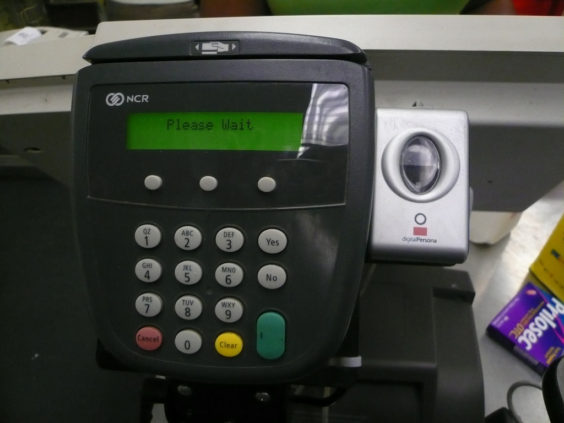
Forget cash and credit cards, how’d you like to scan your eyeball or palm print in order to pay for your groceries? It may seem far-fetched, but some are seeing that in our future.
As grocery stores increasingly emphasize convenience and speed of checkout, the very act of paying for everything seems to slow things down. Have you ever tried paying with cash in a self-checkout station? It takes longer to feed your dollar bills and coins into those little slots, than it takes to do your shopping in the first place. Using plastic is a lot easier, but there’s still swiping, signing and button pushing to do. Could there be an easier, faster way?
The British payment processing company WorldPay says nearly half of the shoppers it surveyed in a new report are interested in biometric forms of payment, like fingerprint, palm and iris scanners. 30% wanted to use their phones, and about a quarter would go for online wallets or payment by text message. The full report has not yet been released, so it’s not clear exactly what the question was, what the choices were, or if there was a “none of the above” option for those who don’t like the sound of any of this.
But the survey does give us an excuse to explore future payment options. A recent report from the National Grocers Association pointed out that just about a dozen years ago, the majority of grocery shoppers paid by check (read: “We Love Paper Coupons, But Not Paper Money”). Today, a mere 8% of shoppers still write checks in the supermarket. So is it unreasonable to think that in the next dozen years, we could see another sea change in the way we pay for our groceries?
Stores like Stop & Shop and Walmart have been testing scan-as-you-go apps, which you can use to scan your own products as you navigate the store (read: “Walmart Plans to Introduce Digital Coupons”). But then you still have to take everything to self-checkout and pay. So Walmart’s “Scan and Go” is really more like “Scan, Pay and Then You Can Go”. There’s been speculation that the apps will include mobile payment options in the future, but so far it hasn’t happened.
Would having to visit a palm print reader, though, really be preferable to an app that adds up your purchases and pays as you go? Would scanning your eyeball really be more efficient than swiping your credit or debit card? And isn’t it all just a little too creepy and invasive?
At least one grocery store implemented a high-tech twist on a low-tech payment method several years ago. Cronig’s Market in Martha’s Vineyard, Massachusetts installed fingerprint readers back in 2009, in order for customers to access their house accounts. Previously, longtime customers had been able to buy now and pay later, with the quaint practice of putting groceries on their tab. But after some abuse of the privilege, the store finally gave in and added the fingerprint reader as a security measure.
More recently, Safeway has been experimenting with a different, less creepy way to speed shoppers through checkout. With “Fast Forward”, shoppers in the Sacramento area are able to link their store loyalty card with their checking account. Then all they have to do is type in their phone number and PIN, and that’s it – not only do they get all the loyalty club prices, but payment is automatically deducted from their bank account.
“I think sometimes when people think about innovation, they think more of Silicon Valley or high-tech companies,” Safeway CEO Robert Edwards told investors recently, when asked about Fast Forward. “Companies in the grocery space generally are not thought about as being that innovative, but it is actually not true.”
Whether that innovation is limited to paying with an app or a phone number, or we end up submitting DNA samples just to get our groceries – only the future will tell.










